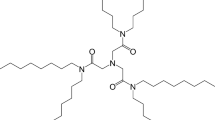Abstract
The mechanisms of magnetite oxidation (forward reaction) and hematite dissociation (reverse reaction) are considered in terms of a general kinetic approach. The dissociation in a pellet is found to develop during sintering when temperature increases. A derivatograph is used to perform experiments with Kachkanar fluxed pellets at various heating rates in a gas containing various oxygen contents. The reaction surface and the dissociation rate are found to increase with the temperature and the slag-forming oxide content. The heating of samples in a reducing atmosphere is studied. The temperature range of reduction of partially dissociated pellets, in which their intense destruction induced by the hematite–magnetite transition does not occur, has been determined. Based on the results of analyzing the pore structure of a pellet, we conclude that, when a melt appears in the system, the dissociation in a pellet is associated with both liquid-phase sintering, when closed porosity forms, and an increase in temperature. The results obtained in this work are of great practical importance, since the use of partially dissociated pellets excludes hematite reduction in them at low temperatures and does not lead to a violation of the gasdynamic conditions of blast-furnace melting.



Similar content being viewed by others
REFERENCES
S. S. Kvon, “Role of the crystal chemical structure of magnetite during its oxidation,” Trudy Karaganda Gos. Tekh. Univ, No. 2, 30–32 (2003).
E. V. Gribanova, A. E. Kuchek, E. S. Vasil’eva, A. A. Voloshin, and V. V. Shutkevich, “Influence of the surface modification of magnetite and hematite on their surface properties,” Vestn. SPbGU, Ser. 4, No. 2, 73–79 (2007).
Y. Guo, J. Xie, J. Gao, H. Xu, and J. Qie, “Manufacture and metallurgical properties of fluxed pellets with a high hematite content,” Metallurg, No. 8, 33–39 (2017).
Yang Xue-Feng, “Mechanism of roasting and agglomeration on the pellets produced by blended iron ore fines of hematite and magnetite,” J. Iron Steel Res. 22 (2), 6 (2010).
T. Ya. Malysheva, Yu. S. Yusfin, and S. V. Plotnikov, “Technological aspects of the production of pellets from magnetite ores,” Izv. Vyssh. Uchebn. Zaved., Chern. Metall., No. 9, 3–5 (2011).
S. V. Plotnikov and A. S. Bormotov, “Mechanism of the phase transformations during oxidative roasting of industrial pellets from the concentrates of ferrous quartzite ores,” Izv. Vyssh. Uchebn. Zaved., Chern. Metall., No. 3, 29–32 (2011).
L. K. Kokorin and S. N. Leleko, Production of Oxidized Pellets: Technology, Equipment (Ural Tsentr PR Reklamy Marat, 2004).
A. G. Bulakh, A. A. Zolotarev, and V. G. Krivovichev, General Mineralogy (Akademiya, Moscow, 2008).
P. W. Readman and W. O. Reilly, “Oxidation processes in titanomagnetites,” Z. Geophis. B 37 (3), 329–338 (1971).
B. P. Yur’ev and N. A. Spirin, “Oxidation of iron-ore pellets,” Steel Trans. 41, 400–403 (2011).
X. Y. Yang, Z. Q. Gong, and F. L. Liu, “Kinetics of Fe3O4 formation by air oxidation,” J. Central South Univ. Technol. 11 (2), 152–155 (2004).
A. Sardari, E. K. Alamdari, and S. Z. Shafaei, “Kinetics of magnetite oxidation under nonisothermal conditions,” Int. J. Miner. Met. Mater. 24 (5), 486–492 (2017).
W. Li, G. Q. Fu, et al., “Oxidation induration process and kinetics of Hongge vanadium titanium-bearing magnetite pellets,” Ironmaking & Steelmaking 44 (4), 294–303 (2017).
T. K. S. Kumar, N. N. Viswanathan, et al., “Investigation of magnetite oxidation kinetics at the particle scale,” Met. Mater. Trans. B. Proc. Met. Mater. Proc. Sci. 50 (1), 150–161 (2019).
V. M. Abzalov, V. A. Gorbachev, S. N. Evstyugin, et al., Physicochemical and Thermal Engineering Fundamentals of Iron Ore Pellet Production, Ed. by L. I. Leont’ev (MITs, Yekaterinburg, 2015).
R. Q. Liang, S. Yang, et al., “Kinetics of oxidation reaction for magnetite pellets,” J. Iron Steel Res. Int. Sep. 20 (9), 16–20 (2013).
T. K. S. Kumar, N. N. Viswanathan, et al., “Developing the oxidation kinetic model for magnetite pellet,” Met. Mater. Trans. B. Proc. Met. Mater. Proc. Sci. 50 (1), 162–172 (2019).
A. K. Zaitsev, S. A. Makeev, V. S. Valavin, and Yu. V. Pokhvisnev, “Dissociation of hematite during dissolution in slag,” Izv. Vyssh. Uchebn. Zaved., Chern. Metall., No. 7, 57–61 (2013).
B. P. Yur’ev, L. B. Bruk, N. A. Spirin, et al., Fundamentals of the Theory of the Processes during Roasting of Iron Ore Pellets (NTI UrFU, Nizhny Tagil, 2018).
Yu. S. Zhukov, N. G. Korshunova, V. Ya. Rekhter, et al., “Dissociation of the hematite of iron ore pellets in combined installations,” Izv. Vyssh. Uchebn. Zaved., Chern. Metall., No. 6, 17–20 (1984).
G. G. Mikhailov, B. I. Leonovich, and Yu. S. Kuznetsov, Thermodynamics of Metallurgical Processes and Systems (Izd. Dom MISiS, Moscow, 2009).
O. A. Yesin and P. V. Gel’d, Physical Chemistry of Pyrometallurgical Processes. Part1 (Metallurgizdat, Sverdlovsk, 1962).
A. N. Shapovalov, Theory of Metallurgical Processes (NFNITU MISiS, Novotroitsk, 2015).
B. V. Kachula, “Volumetric changes and strength properties of pellets made of titanium–magnetic concentrates during reduction,” Candidate’s Dissertation in Engineering (Inst. Metallurg. UrO RAN, Sverdlovsk, 1973).
S. T. Rostovtsev, Theory of Metallurgical Processes (Metallurgizdat, Moscow, 1956).
Yu. N. Lopatin, “Hardening of partially oxidized pellets estimated from the kinetics of their oxidation and stressed state at the boundary of magnetite and hematite zones,” Candidate’s Dissertation in Engineering (Sverdlovsk, 1985).
Author information
Authors and Affiliations
Corresponding author
Ethics declarations
The authors declare that they have no conflicts of interest.
Additional information
Translated by K. Shakhlevich
Rights and permissions
About this article
Cite this article
Yur’ev, B.P., Dudko, V.A. & Nikonenko, E.A. Hematite Dissociation Mechanism and Kinetics in Iron Ore Pellets during Heat Treatment. Russ. Metall. 2022, 481–487 (2022). https://doi.org/10.1134/S0036029522050123
Received:
Revised:
Accepted:
Published:
Issue Date:
DOI: https://doi.org/10.1134/S0036029522050123




